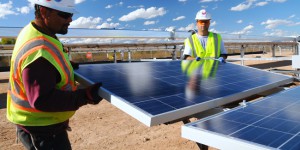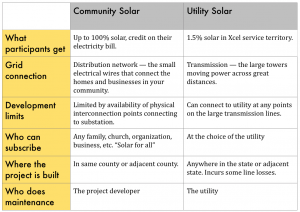It’s a big week for the future of solar in Minnesota. Will we get “solar for all” or will we get something less?
In 2013, Minnesota passed two laws to take advantage of the rapidly declining costs of solar electricity:
- A solar energy standard, requiring that the state’s investor-owned utilities generate 1.5 percent of their electricity from solar by 2020.
- A requirement that the state’s largest electric monopoly, Xcel Energy, make a community solar program available to customers in its service territory. The specifics of the community solar program were directly negotiated and agreed to by Xcel Energy in order to provide a “solar for all” offering that any customer could choose.
Moving with diligence, Xcel has already finalized plans to meet its solar energy standard requirements three years early. When construction on the projects is completed, everyone in Xcel service territory will be getting 1.5 percent solar as part of the standard electricity mix. In its June 1 solar energy standard report, Xcel reported on this success and said that it will not build any additional utility solar on its system until 2025.
The community solar program that allows anyone to purchase 100 percent of their power from solar has been an entirely different picture. In numerous filings with the Public Utilities Commission, Xcel has sought to delay and dramatically change the rules of the program — even threatening to unilaterally cancel more than 75 percent of all proposed projects. It’s been eyebrow-raising behavior from the state’s largest monopoly that normally has a good working relationship with the Commission.
One of the challenges stems from Xcel confusing utility solar with community solar. Today, both programs rely on ground-mounted solar, but that’s where the similarities end.
Three Phases of Community Solar Development
The first phase of a successful community solar program is getting the rules right. Minnesota settled this back in September of 2014 at the Public Utilities Commission.
The second phase is attracting community anchors — “anchor tenants” — to ensure that solar sites can secure the financing need for construction.
The third stage is filling out the community solar gardens with a broad diversity of residential subscribers — two companies last week announced programs intending to offer community solar to many of Minnesota’s 600,000 renters who are otherwise unable to choose solar.
Throughout this three-phase process, garden developers are contributing to our shared prosperity though job creation, while also making solar accessible to those with less means, who have been most effected by poor air quality, the opportunity to participate.
Developers have secured financing and built their projects in accordance with the rules approved in 2014 by the Public Utilities Commission and implemented by Xcel when they opened the community solar program December. Now, Xcel is pushing for retroactive changes that would jeopardize two years worth of project development, dozens of signed contracts, major private sector investments, and numerous hiring decisions.
If left to their own plans, Xcel would have all Minnesotans wait until 2025 to go beyond 1.5 percent solar.
Thinking about the decisions ahead this week, there’s a simple question to ask — should we ignore what customers want or should we enforce the rules of the program as they were agreed upon last year?

